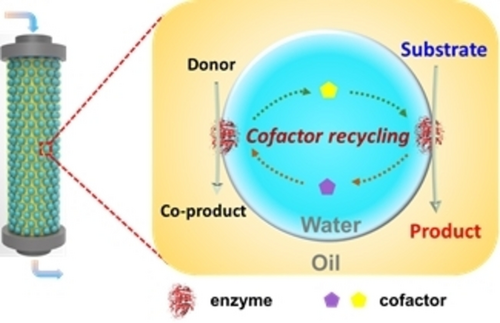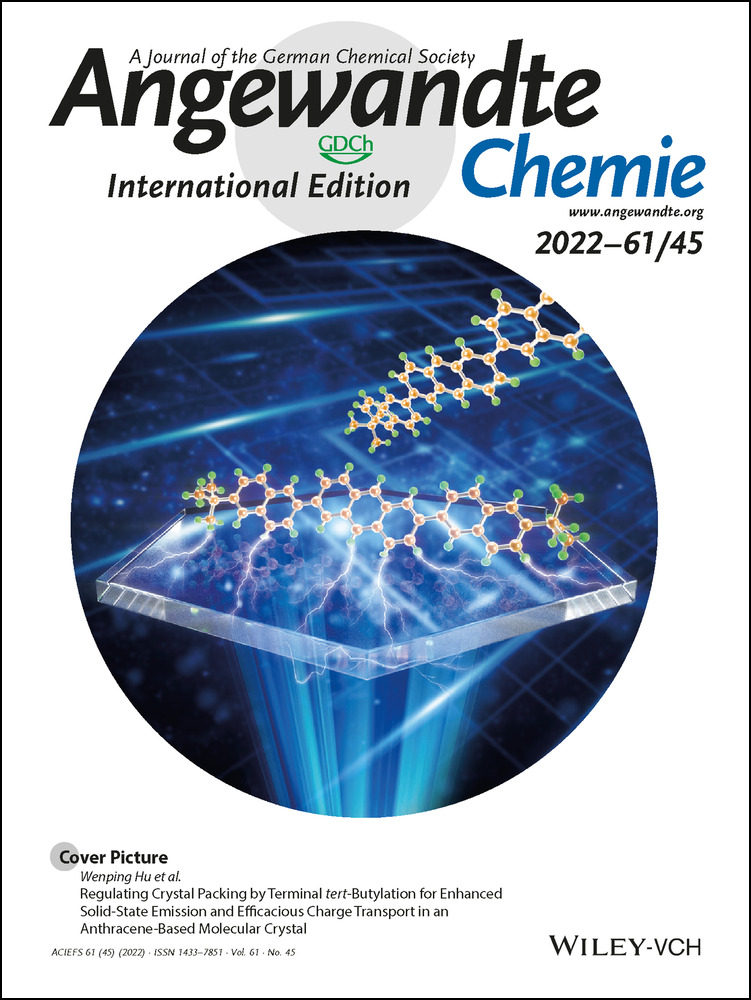Co-compartmentalization of Enzymes and Cofactors within Pickering Emulsion Droplets for Continuous-Flow Catalysis
Wei Wei
School of Chemistry and Chemical Engineering, Shanxi University, Taiyuan, 030006 China
Search for more papers by this authorDr. Rammile Ettelaie
Food Colloids Group, School of Food Science and Nutrition, University of Leeds, Leeds, LS2 9JT UK
Search for more papers by this authorXiaoming Zhang
School of Chemistry and Chemical Engineering, Shanxi University, Taiyuan, 030006 China
Search for more papers by this authorMin Fan
School of Chemistry and Chemical Engineering, Shanxi University, Taiyuan, 030006 China
Search for more papers by this authorYue Dong
School of Chemistry and Chemical Engineering, Shanxi University, Taiyuan, 030006 China
Search for more papers by this authorDr. Zebiao Li
Nantong Chanyoo Pharmatech Co., Ltd., Nantong, 226400 China
Search for more papers by this authorCorresponding Author
Prof. Hengquan Yang
School of Chemistry and Chemical Engineering, Shanxi University, Taiyuan, 030006 China
Search for more papers by this authorWei Wei
School of Chemistry and Chemical Engineering, Shanxi University, Taiyuan, 030006 China
Search for more papers by this authorDr. Rammile Ettelaie
Food Colloids Group, School of Food Science and Nutrition, University of Leeds, Leeds, LS2 9JT UK
Search for more papers by this authorXiaoming Zhang
School of Chemistry and Chemical Engineering, Shanxi University, Taiyuan, 030006 China
Search for more papers by this authorMin Fan
School of Chemistry and Chemical Engineering, Shanxi University, Taiyuan, 030006 China
Search for more papers by this authorYue Dong
School of Chemistry and Chemical Engineering, Shanxi University, Taiyuan, 030006 China
Search for more papers by this authorDr. Zebiao Li
Nantong Chanyoo Pharmatech Co., Ltd., Nantong, 226400 China
Search for more papers by this authorCorresponding Author
Prof. Hengquan Yang
School of Chemistry and Chemical Engineering, Shanxi University, Taiyuan, 030006 China
Search for more papers by this authorGraphical Abstract
A continuous-flow biocatalytic system based on the co-compartmentalization of enzymes and cofactors within Pickering emulsion droplets has been developed. As exemplified by enzyme-catalyzed ketone enantioselective reduction and enantioselective transamination, this system features long-term operational stability, excellent catalytic efficiency and no need for exogenous cofactors.
Abstract
Co-immobilization of enzymes and cofactors in a manner suitable for use in continuous flow catalysis remains a great challenge because of the difficulty in ensuring the free accessibility of immobilized enzymes and cofactors. Herein, we present a continuous flow catalysis system based on co-compartmentalization of enzymes and cofactors within Pickering emulsion droplets, enabling regeneration of cofactors within the droplets. As exemplified by enzyme-catalyzed ketone enantioselective reduction and enantioselective transamination, our systems exhibit long-term stability (300–400 h), outstanding total turnover number (TTN, 59204 mol mol−1) and several-fold enhancement in the enzyme catalytic efficiency (CEe) in comparison to conventional biphasic reactions. As well as giving insight into the co-compartmentalization effects, our system will provide the opportunity to significantly advance continuous-flow biocatalysis towards the level of practical applications.
Conflict of interest
The authors declare no conflict of interest.
Open Research
Data Availability Statement
Data sharing is not applicable to this article as no new data were created or analyzed in this study.
Supporting Information
As a service to our authors and readers, this journal provides supporting information supplied by the authors. Such materials are peer reviewed and may be re-organized for online delivery, but are not copy-edited or typeset. Technical support issues arising from supporting information (other than missing files) should be addressed to the authors.
| Filename | Description |
|---|---|
| anie202211912-sup-0001-misc_information.pdf2.3 MB | Supporting Information |
Please note: The publisher is not responsible for the content or functionality of any supporting information supplied by the authors. Any queries (other than missing content) should be directed to the corresponding author for the article.
References
- 1
- 1aB. Gutmann, D. Cantillo, C. O. Kappe, Angew. Chem. Int. Ed. 2015, 54, 6688–6728; Angew. Chem. 2015, 127, 6788–6832;
- 1bB. Pieber, M. Shalom, M. Antonietti, P. H. Seeberger, K. Gilmore, Angew. Chem. Int. Ed. 2018, 57, 9976–9979; Angew. Chem. 2018, 130, 10127–10131;
- 1cR. Greifenstein, T. Ballweg, T. Hashem, E. Gottwald, D. Achauer, F. Kirschhöfer, M. Nusser, G. Brenner-Weiss, E. Sedghamiz, W. Wenzel, E. Mittmann, K. S. Rabe, C. M. Niemeyer, M. Franzreb, C. Wöll, Angew. Chem. Int. Ed. 2022, 61, e202117144;
- 1dJ. Britton, R. P. Dyer, S. Majumdar, C. L. Raston, G. A. Weiss, Angew. Chem. Int. Ed. 2017, 56, 2296–2301; Angew. Chem. 2017, 129, 2336–2341;
- 1eJ. Britton, S. Majumdar, G. A. Weiss, Chem. Soc. Rev. 2018, 47, 5891–5918;
- 1fM. Romero-Fernández, F. Paradisi, Curr. Opin. Chem. Biol. 2020, 55, 1–8;
- 1gL. Tamborini, P. Fernandes, F. Paradisi, F. Molinari, Trends Biotechnol. 2018, 36, 73–88;
- 1hS. Kundu, A. S. Bhangale, W. E. Wallace, K. M. Flynn, C. M. Guttman, R. A. Gross, K. L. Beers, J. Am. Chem. Soc. 2011, 133, 6006–6011;
- 1iA. Adamo, R. L. Beingessner, M. Behnam, J. Chen, T. F. Jamison, K. F. Jensen, J. M. Monbaliu, A. S. Myerson, E. M. Revalor, D. R. Snead, T. Stelzer, N. Weeranoppanant, S. Y. Wong, P. Zhang, Science 2016, 352, 61–67.
- 2
- 2aS. Wu, R. Snajdrova, J. C. Moore, K. Baldenius, U. T. Bornscheuer, Angew. Chem. Int. Ed. 2021, 60, 88–119; Angew. Chem. 2021, 133, 89–123;
- 2bR. A. Sheldon, S. Van Pelt, Chem. Soc. Rev. 2013, 42, 6223–6235;
- 2cP. Jonkheijm, D. Weinrich, H. Schrder, C. M. Niemeyer, H. Waldmann, Angew. Chem. Int. Ed. 2008, 47, 9618–9647; Angew. Chem. 2008, 120, 9762–9792;
- 2dU. Hanefeld, F. Hollmann, C. E. Paul, Chem. Soc. Rev. 2022, 51, 594–627;
- 2eC. Hu, Z. Huang, M. Jiang, Y. Tao, Z. Li, X. Wu, D. Cheng, F. Chen, ACS Sustainable Chem. Eng. 2021, 9, 8990–9000.
- 3
- 3aJ. Liang, S. Gao, J. Liu, M. Y. B. Zulkifli, J. Xu, J. Scott, V. C. Chen, J. Shi, A. Rawal, K. Liang, Angew. Chem. Int. Ed. 2021, 60, 5421–5428; Angew. Chem. 2021, 133, 5481–5488;
- 3bY. Q. Zhang, T. T. Feng, Y. F. Cao, X. Y. Zhang, T. Wang, M. R. H. Nina, L. C. Wang, H. L. Yu, J. H. Xu, J. Ge, Y. P. Bai, ACS Catal. 2021, 11, 10487–10493;
- 3cT. Peschke, M. Skoupi, T. Burgahn, S. Gallus, I. Ahmed, K. S. Rabe, C. M. Niemeyer, ACS Catal. 2017, 7, 7866–7872;
- 3dT. Peschke, P. Bitterwolf, S. Gallus, Y. Hu, C. Oelschlaeger, N. Willenbacher, K. S. Rabe, C. M. Niemeyer, Angew. Chem. Int. Ed. 2018, 57, 17028–17032; Angew. Chem. 2018, 130, 17274–17278.
- 4
- 4aS. Velasco-Lozano, A. I. Benítez-Mateos, F. López-Gallego, Angew. Chem. Int. Ed. 2017, 56, 771–775; Angew. Chem. 2017, 129, 789–793;
- 4bC. J. Hartley, C. C. Williams, J. A. Scoble, Q. I. Churches, A. North, N. G. French, T. Nebl, G. Coia, A. C. Warden, G. Simpson, A. R. Frazer, C. N. Jensen, N. J. Turner, C. Scott, Nat. Catal. 2019, 2, 1006–1015;
- 4cA. I. Benítez-Mateos, M. L. Contente, S. Velasco-Lozano, F. Paradisi, F. López-Gallego, ACS Sustainable Chem. Eng. 2018, 6, 13151–13159;
- 4dH. Zhao, W. A. Van Der Donk, Curr. Opin. Biotechnol. 2003, 14, 583–589;
- 4eL. Nagy-Győr, E. Abaházi, V. Bódai, P. Sátorhelyi, B. Erdélyi, D. Balogh-Weiser, C. Paizs, G. Hornyánszky, L. Poppe, ChemBioChem 2018, 19, 1845–1848;
- 4fW. Liu, P. Wang, Biotechnol. Adv. 2007, 25, 369–384;
- 4gB. Baumer, T. Classen, M. Pohl, J. Pietruszka, Adv. Synth. Catal. 2020, 362, 2894–2901;
- 4hA. P. Mattey, G. J. Ford, J. Citoler, C. Baldwin, J. R. Marshall, R. B. Palmer, M. Thompson, N. J. Turner, S. C. Cosgrove, S. L. Flitsch, Angew. Chem. Int. Ed. 2021, 60, 18660–18665;
- 4iM. Zoumpanioti, H. Stamatis, A. Xenakis, Biotechnol. Adv. 2010, 28, 395–406;
- 4jC. Wu, S. Bai, M. B. Ansorge-Schumacher, D. Wang, Adv. Mater. 2011, 23, 5694–5699.
- 5
- 5aM. Pera-Titus, L. Leclercq, J. M. Clacens, F. De Campo, V. Nardello-Rataj, Angew. Chem. Int. Ed. 2015, 54, 2006–2021; Angew. Chem. 2015, 127, 2028–2044;
- 5bZ. Sun, U. Glebe, H. Charan, A. Bçker, C. Wu, Angew. Chem. Int. Ed. 2018, 57, 13810–13814; Angew. Chem. 2018, 130, 14006–14010;
- 5cJ. Potier, S. Menuel, M. H. Chambrier, L. Burylo, J. F. Blach, P. Woisel, E. Monflier, F. Hapiot, ACS Catal. 2013, 3, 1618–1621;
- 5dM. Kim, S. J. Yeo, C. B. Highley, J. A. Burdick, P. J. Yoo, J. Doh, D. Lee, ACS Nano 2015, 9, 8269–8278;
- 5eH. Jiang, Y. Li, L. Hong, T. Ngai, Chem. Asian J. 2018, 13, 3533–3539;
- 5fQ. Wei, C. Yu, X. Song, Y. Zhong, L. Ni, Y. Ren, W. Guo, J. Yu, J. Qiu, J. Am. Chem. Soc. 2021, 143, 6071–6078;
- 5gH. Wu, X. Du, X. Meng, D. Qiu, Y. Qiao, Nat. Commun. 2021, 12, 6113;
- 5hZ. Wang, M. C. M. Van Oers, F. P. J. T. Rutjes, J. C. M. Van Hest, Angew. Chem. Int. Ed. 2012, 51, 10746–10750; Angew. Chem. 2012, 124, 10904–10908;
- 5iP. A. Zapata, J. Faria, M. P. Ruiz, R. E. Jentoft, D. E. Resasco, J. Am. Chem. Soc. 2012, 134, 8570–8578.
- 6
- 6aM. Zhang, L. Wei, H. Chen, Z. Du, B. P. Binks, H. Yang, J. Am. Chem. Soc. 2016, 138, 10173–10183;
- 6bM. Zhang, R. Ettelaie, T. Yan, S. Zhang, F. Cheng, B. P. Binks, H. Yang, J. Am. Chem. Soc. 2017, 139, 17387–17396.
- 7
- 7aZ. Li, H. Yang, J. Liu, Z. Huang, F. Chen, Chem. Rec. 2021, 21, 1611–1630;
- 7bM. L. Contente, F. Paradisi, Nat. Catal. 2018, 1, 452–459;
- 7cM. Heidlindemann, G. Rulli, A. Berkessel, W. Hummel, H. Gröger, ACS Catal. 2014, 4, 1099–1103;
- 7dJ. Cao, T. K. Hyster, ACS Catal. 2020, 10, 6171–6175;
- 7eF. Hollmann, I. W. C. E. Arendsa, D. Holtmannb, Green Chem. 2011, 13, 2285–2313;
- 7fX. Chen, L. Xu, A. Wang, H. Li, C. Wang, X. Pei, P. Zhang, S. G. Wu, J. Chem. Technol. Biotechnol. 2019, 94, 236–243.
- 8
- 8aC. J. Beverung, C. J. Radke, H. W. Blanch, Biophys. Chem. 1999, 81, 59–80;
- 8bS. Rusli, J. Grabowski, A. Drews, M. Kraume, Processes 2020, 8, 1082;
- 8cJ. Maldonado-Valderrama, V. B. Fainerman, E. Aksenenko, M. J. Galvez-Ruiz, M. A. Cabrerizo-Vílchez, R. Miller, Colloids Surf. A 2005, 261, 85–92.
- 9E. Diamanti, J. Santiago-Arcos, D. Grajales-Hernández, N. Czarnievicz, N. Comino, I. Llarena, D. D. Silvio, A. L. Cortajarena, F. López-Gallego, ACS Catal. 2021, 11, 15051–15067.
- 10
- 10aA. Heysea, C. Plikatb, M. Grüna, S. Delavala, M. Ansorge-Schumacherb, A. Drews, Process Biochem. 2018, 72, 86–95;
- 10bC. Plikat, A. Drews, M. B. Ansorge-Schumacher, ChemCatChem 2022, 14, e202200444;
- 10cS. Tcholakova, N. D. Denkov, A. Lips, Phys. Chem. Chem. Phys. 2008, 10, 1608–1627;
- 10dA. Sarkar, B. Murray, M. Holmes, R. Ettelaie, A. Abdalla, X. Yang, Soft Matter 2016, 12, 3558–3569.
- 11
- 11aL. Day, J. Zhai, M. Xu, N. C. Jones, S. V. Hoffmann, T. J. Wooster, Food Hydrocolloids 2014, 34, 78–87;
- 11bE. Dickinson, Colloid Surf. B-Biointerfaces 2010, 81, 130–140;
- 11cS. Das, S. Behera, S. Balasubramanian, J. Phys. Chem. Lett. 2020, 11, 2977–2982.
- 12
- 12aR. C. Simon, N. Richter, E. Busto, W. Kroutil, ACS Catal. 2014, 4, 129–143;
- 12bS. A. Kelly, S. Pohle, S. Wharry, S. Mix, C. C. R. Allen, T. S. Moody, B. F. Gilmore, Chem. Rev. 2018, 118, 349–367;
- 12cF. G. Mutti, T. Knaus, N. S. Scrutton, M. Breuer, N. J. Turner, Science 2015, 349, 1525–1529;
- 12dI. V. Pavlidis, M. S. Weiss, M. Genz, P. Spurr, S. P. Hanlon, B. Wirz, H. Iding, U. T. Bornscheuer, Nat. Chem. 2016, 8, 1076–1082;
- 12eL. Marx, N. Ríos-Lombardía, J. F. Farnberger, W. Kroutil, A. I. Benítez-Mateos, F. López-Gallego, F. Morís, J. González-Sabín, P. Berglund, Adv. Synth. Catal. 2018, 360, 2157–2165.





